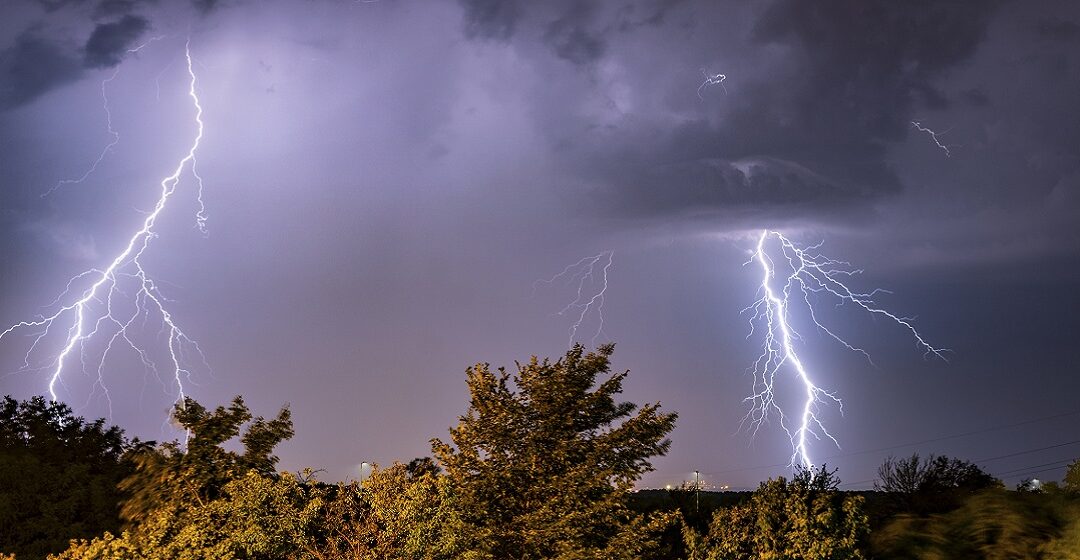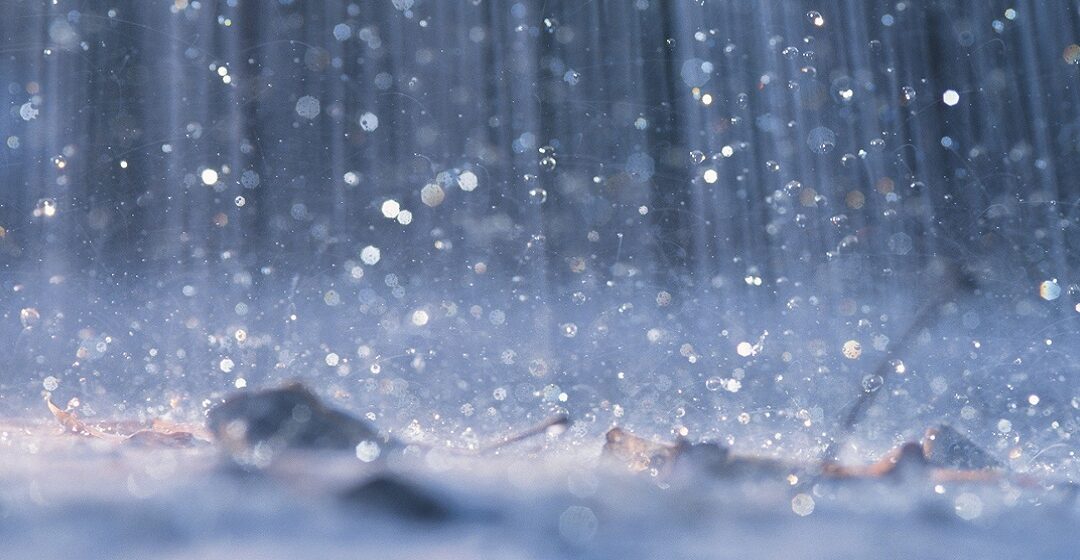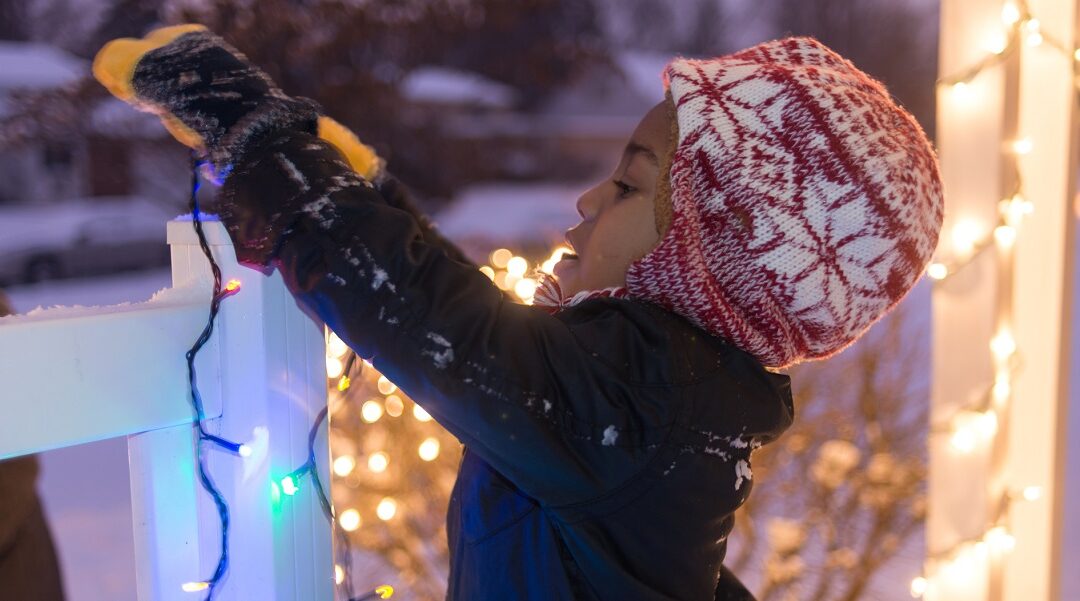
May 30, 2024 | Storms and Outages
Summer is on the horizon, which often means severe weather, including thunder and lightning. But even with the best preparation, storms or lightning strikes may cause outages. We’re prepared to respond to any storms that hit our area this summer and always. And if outages occur, we’ll work around the clock as safely and quickly as possible to get your lights back on.
Watch this video to learn more about how we prepare.
We want you and your family to be prepared for storms as well.
Here are a few tips to stay safe during summer storms.
When thunder roars, go indoors!
Did you know: According to the National Weather Service, lightning strikes the United States about 25 million times per year?
If the sky looks threatening or you hear thunder, even in the distance, immediately seek shelter. The safest place during a thunder and lightning storm is in an enclosed permanent building or metal-topped vehicle with all doors and windows closed. Outdoor tents or gazebos will not keep you safe from a lightning strike.
Before a storm:
- Prepare an emergency kit with food, water, medication, flashlights and pet supplies.
- Charge your phones and devices.
- Purchase power strips with lightning arrestors or surge protectors for your appliances and electronics.
- Adjust your alert preferences to stay informed in case of an outage at pplelectric.com/alerts.
During a storm:
- Stay away from utility poles and metal conductors.
- Electric and plumbing equipment may carry lightning current. Avoid using any appliances or electronics plugged into an electrical outlet.
- Don’t use water to wash dishes or take a shower.
- Stay away from windows and doors.
- Report an outage, or check the status of an outage, at pplelectric.com/outage.
- And finally, remember to stay indoors for at least 30 minutes after thunder stops.
Source: lightningsafetycouncil.org

Sep 7, 2023 | Safety and Security
September is National Preparedness Month, and amid an active storm season, we encourage you to plan ahead so you’re ready if an emergency strikes.
“This year, we have already experienced 36 storms across the regions we serve,” said Sal Salet, vice president of Distribution Operations. “While we continually maintain and upgrade our grid to better withstand more severe storms, we recommend all of our customers plan ahead to be ready for any emergency.”
Here are a few steps to get you started:
- Make a plan: Develop an emergency plan including everyone in your household so you’ll know how and where to meet, how you’ll contact each other and what to do in different situations.
- Be prepared: Prepare an emergency kit, including non-perishable food, water, medication, first aid supplies and any pet supplies you may need. Also include batteries and battery-operated flashlights. Store your emergency kit in one location that’s easy for everyone to find and preferably in an air-tight container.
- Stay Informed: We use several ways to communicate before storms and during emergencies. One way to stay informed is through alerts. Sign into your online account and adjust your alert preferences at pplelectric.com/alerts. You can choose to receive a phone call, email, or text message for status updates about an outage. For more tips on reporting outages and staying safe during a storm, visit pplelectric.com/outage.
We also take storm-prep very seriously and constantly prepare for emergencies. Here are a few things we do to prevent outages:
- Ongoing investments: Throughout the year, we make key investments to strengthen our electric system to be more resilient against severe weather. This work includes investments in grid automation, comprehensive line clearing and enhancements to power lines, poles, and other equipment. Since 2015, our smart grid technology alone has avoided more than 1.7 million outages.
- Training and safety measures: Our teams are constantly training on storm-response techniques and practicing how we respond and dispatch crews. Leading up to severe weather, our team monitors the weather and its impact across surrounding regions so we already have crews ready to respond when the storm hits.
- Mutual response: We maintain mutual assistance relationships that provide access to critical resources and hundreds of crews in 29 states and four provinces in Canada when mobilizing for potential large-scale restoration efforts.
“Our customers are always top priority,” said Salet. “That remains true whether we are restoring power after a storm or planning investments to our grid.”
Don’t wait for a storm to hit. Use National Preparedness Month as a reminder to make a plan, create a kit and be prepared for any type of emergency. Stay safe!

May 24, 2023 | Reliability, Storms and Outages
As summer approaches, so does the start of the summer storm season.
We want you to know we’re prepared to continue delivering safe and reliable service in all kinds of weather.
One way we keep the lights on during storms is through the investments we’ve made in our Smart Grid. If an outage occurs, our self-healing grid can sense the problem and automatically reroute power to restore as many customers as possible, almost instantly. This technology — along with replacing older equipment, upgrading to storm-resistant poles and wires and using data to proactively trim trees before they fall on wires — helps us reduce outages and respond quicker if an outage occurs.
We’ve also made it easier than ever to stay informed. You can customize your outage alerts to receive a phone call, text message or email with updates on repair crew status and estimated restoration times if you lose power. You can customize those alerts and also sign up for billing and payment alerts on our Alert Preferences page.
Even with the best preparation and information, storms and severe weather can cause damage and result in outages. We keep our outage map updated with real-time information on outage causes and estimated restoration times. If your power goes out, you can help us by reporting your outage in a few simple steps on our Outages and Issues page.
No matter what Mother Nature throws our way, we’ll be ready. And, our crews will be there to work as safely and quickly as possible to restore power if needed.

Dec 22, 2022 | Storms and Outages
Power outage? Text “outage” to “TXTPPL” or report it here.
Update: 12.24.22, 6 p.m.
- Winter Storm Elliott, which began Thursday afternoon, has caused power outages across our territory.
- As of approximately 6 p.m., less than 2,000 of our 1.4 million customers were without power.
- Since the beginning of the storm, our crews have restored power for nearly 102,000 customers.
- Our crews continue to work to restore each and every customer as safely and quickly as possible. The best way to stay up to date on your specific outage is through PPL Alerts here. You can also check the status of an outage here.
- We’re expecting very cold temperatures throughout the weekend. Please read the extreme cold safety tips below. Stay safe and be well.
Update: 12.24.22, 12 p.m.
- Winter Storm Elliott, which began Thursday afternoon, has caused power outages across our territory. If additional outages occur today, we’re prepared to respond.
- As of approximately noon, about 5,000 of our 1.4 million customers were without power.
- Since the beginning of the storm, our crews have restored power for nearly 100,000 customers.
- Our crews — as well as crews from peer utilities — continue to work to restore each and every customer as safely and quickly as possible. The best way to stay up to date on your specific outage is through PPL Alerts at pplelectric.com/alerts. You can also check the status of an outage online at pplelectric.com/outage
Update: 12.23.22, 4 p.m.
- Winter Storm Elliott, which began Thursday afternoon, has caused power outages, and we’re expecting more outages as the storm evolves.
- As of approximately 4 p.m., about 32,000 of our 1.4 million customers were without power.
- Since the beginning of the storm, our crews have restored power for more than 53,000 customers.
- Our crews — as well as crews from peer utilities — continue to work to restore each and every customer as safely and quickly as possible. The best way to stay up to date on your specific outage is through PPL Alerts at pplelectric.com/alerts. You can also check the status of an outage online at pplelectric.com/outage
- The temperature is falling and we’re expecting very cold temperatures throughout the weekend. We encourage our customers to stay safe during this time.
Update: 12.23.22, 10:30 a.m.
The forecast is calling for plummeting temperatures as an artic front moves through the area. Please stay safe and be prepared with these tips:
- Prepare and maintain an emergency kit with food, water, medication and any pet supplies you may need.
- Open curtains on your south-facing windows during the day to allow sunlight to naturally heat your home and close them at night to reduce the chill you may feel from cold windows.
- Heat loss is even greater during periods of extreme cold. Cover drafty windows. Roll up a towel or blanket for the bottom of drafty exterior doors. (When possible, add caulk or weather stripping to seal air leaks around leaky doors and windows.)
- When you are home and awake, set your thermostat as low as is comfortable. (If you raise the thermostat, your home will use more energy.)
- Before going to sleep or if you’re out of the house, turn your thermostat back 10° to 15° for eight hours and save around 10% a year on your heating and cooling bills.
- Keep your fireplace damper closed unless a fire is burning. Keeping the damper open is like keeping a window wide open during the winter; it allows warm air to go right up the chimney.
- Check the seal on the fireplace flue damper and make it as snug as possible.
- If you have a power outage, avoid using candles for lighting because they can start fires. Use flashlights instead.
- If you use a portable generator, never operate it in your home, garage or any enclosed area where deadly carbon monoxide fumes can accumulate.
- If you rely on medical equipment or have special personal needs, plan what you would do in the event of an extended power outage at your home.
Update: 12.23.22, 9 a.m.
- Winter Storm Elliott, which began Thursday afternoon, has caused power outages. We’re expecting more outages throughout the day as winds ramp up and temperatures plummet. Our crews — as well as crews from peer utilities — continue to work to restore each and every customer as safely and quickly as possible.
- As of approximately 9 a.m., about 2,600 of our 1.4 million customers were without power.
- Since the beginning of the storm, our crews have restored power for more than 20,000 customers.
Update: 12.22.22, 1 p.m.
Winter Storm Elliott has entered our area and is expected to bring rain, wintry precipitation, heavy winds, and plummeting temperatures through Saturday. With a storm of this magnitude, we are expecting power outages. We want you to know that we’re ready to respond.
We have more than 2,000 employees from our own team and peer utilities prepared to support our restoration efforts. We’ll work as safely and quickly as possible to assess damage and restore power to all customers who are impacted.
We’ll be posting updates on this page throughout the storm. If you need to report an outage, check estimated restoration times, or adjust your alert preferences, click here.
While we’ve prepared for possible outages, we want you to be prepared too:
- Charge your cell phones, portable chargers, and other electronic devices so they’re ready to use in case of an emergency.
- Prepare or update your emergency kit with food, water, medication, and pet supplies.
- Double check your flashlights for batteries.
- If you have a portable generator, test it to make sure it’s working, but don’t operate in an enclosed area, like a garage, where carbon monoxide fumes could accumulate.
- Assume any downed power line is energized. Stay clear by at least 100 feet and keep kids and pets away. If you see a downed power line, report it immediately by calling 1-800-342-5775.

Dec 14, 2022 | Safety and Security
Deck the Halls and do it safely.
Fa la la la la, la la la la.
The holiday season is upon us. It’s the time of year for fun, cheer, and holiday lights! With all the hustle and bustle of the season, it’s important to keep safety — particularly electrical safety — at the top of your holiday list.
Did you know that nearly 5,000 people visit the emergency room each holiday season due to indoor and outdoor electric decoration mishaps, according to the United States Consumer Product and Safety Commission?
Don’t be part of that statistic. Here are six tips, courtesy of Electric Safety Foundation International (EFSI), to keep you safe while decking the halls:
- Check it Twice — Be sure to check strings of lights for broken bulbs, cracked sockets or loose connections. Also check each decoration’s electrical cord to ensure they are not frayed or cut.
- Easy There Clark — When hooking up electrical holiday decorations, don’t overload circuits, outlets, or extension cords with too many plugs. Remember to always follow the manufacturer’s guidelines for how many sets of lights can be safely connected. Too many strings can cause a potential overload, which is one of the leading causes of house fires.
- Up on the Rooftop — When stringing up outdoor lights, always use a dry wooden or fiberglass ladder and stay clear of any overhead powerlines. You, your decorations, and your equipment should be at least 10 feet away from powerlines at all times.
- Hang them with Care — When hanging electrical holiday decorations, don’t use nails, screws, tacks, or staples to hang them. Piercing the cord could damage the wire’s insulation and cause electrical shock or fire. Try using plastic or insulated clips instead.
- Home Alone — If you are leaving the house, be sure you turn off your holiday lights and decorations. And do the same when you’re sleeping. Using an automatic timer can make it easier to turn everything off, or on, precisely when you want to.
- Bah Hum-Rug — When decorating indoors, don’t run any extension cords under rugs or carpets. Plus, be sure to discard any older, outdated, or damaged extension cords to help prevent the risk of a fire.
Don’t let something preventable ruin your holiday season. A little bit of preparation can help you make your season bright, and most importantly, safe.





